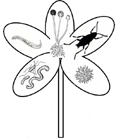
Editorial Board
Evaluation Reviewers
Instructions to Authors
Evaluation Process
Paper Submission
Objective & Policy
Number of visits :
- Current Issue -

- Previous Issue -


Last update : June 2025
- Current Editorial -
Functional Biodiversity and Crop Protection
|
Modern agriculture faces major challenges: climate change, soil fertility decline, pest pressure, and growing dependence on chemical inputs. At the heart of these issues lies a silent yet vital ally: functional biodiversity which is the ensemble of living organisms that support agricultural productivity through their ecological interactions. However, this biodiversity -especially pollinators and beneficial insects - is severely threatened by intensive farming practices. In the context of an urgent agro-ecological transition, it is imperative to reintegrate these ecosystem services into our production systems.
So-called "beneficial" insects perform essential ecological functions. Pollinators (bees, hoverflies, butterflies, wasps…) enable the reproduction of many fruit and vegetable crops. Other arthropods, such as ladybugs, ground beetles, lacewings, or predator and parasitic wasps, naturally regulate pest populations. Some also play a role in decomposing organic matter and structuring soil, enhancing the resilience of agroecosystems.
These beneficial interactions have a real, often underestimated economic impact. For instance, insect pollination alone contributes billions of dollars to global agricultural production annually.
Unfortunately, this functional biodiversity is in decline. The massive use of pesticides, simplification of agricultural landscapes (monocultures, intensive tillage), loss of hedgerows, and pollution directly harm populations of beneficial insects. Climate change exacerbates ecological imbalances by disrupting the timing of plant and pollinator life cycles. It is becoming increasingly clear that crop protection can no longer rely solely on synthetic chemicals. Nature must be brought back into the fields.
Several agro-ecological techniques help restore biodiversity while ensuring effective crop protection:
- Flower strips placed along or within fields, offer nectar, pollen, and shelter for beneficial insects. They promote their long-term establishment and improve natural pest regulation.
- Intercropping, or mixed cropping, involves growing two or more plant species together in the same field. This diversification creates a mosaic of microhabitats, disrupts pest life cycles, and stimulates beneficial plant-insect interactions.
- Farming Alternatives with Pollinators (FAP) is a strategy that integrates pollinator-friendly practices into cropping systems to enhance both biodiversity and productivity. This includes selecting flowering plants that overlap with crop bloom periods, reducing pesticide exposure during critical foraging times, and designing field layouts that facilitate pollinator movement. FAP approaches prioritize the co-existence of farming and pollination services, making pollinators active contributors to sustainable agriculture rather than incidental visitors.
- Crop rotation breaks pest life cycles and promotes plant diversity, which is beneficial to natural enemies.
- Hedgerows, when diversified and well managed, serve as ecological corridors, nesting sites, and food sources for beneficial fauna.
- Cover crops and green manures grown between main crops, protect the soil, support diverse insect communities, and improve soil fertility and structure.
- Lastly, reducing chemical inputs (pesticides, synthetic fertilizers) is essential for maintaining ecological balance. Organic farming and biocontrol methods are promising strategies that should be more widely adopted.
Promoting functional biodiversity does not mean sacrificing agricultural productivity, but rather redefining our approach to crop protection. The goal is no longer to fight nature, but to work with it. This requires farmer education, technical support, and above all, public policies that recognize and reward the ecosystem services provided by agro-ecological practices.
By valuing functional biodiversity, we reconcile agriculture with ecology. We build farming systems that are more resilient, less dependent on external inputs, and better equipped to meet future challenges. In doing so, we lay one of the most solid foundations for truly sustainable food sovereignty.
Dr. Ikbal Chaieb,
CRRHAB Chott-Mariem,
University of Sousse, Tunisia